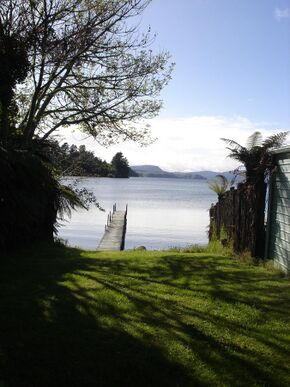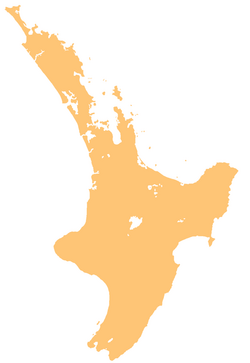Earth:Lake Rotoiti (Bay of Plenty)
| Lake Rotoiti | |
|---|---|
 Lake Rotoiti | |
 Bathymetric map of Lake Rotoiti[1] | |
| Location | Rotorua Lakes, Bay of Plenty Region, North Island |
| Coordinates | [ ⚑ ] : 38°02′20″S 176°25′40″E / 38.0390°S 176.4277°E |
| Type | crater lake |
| rivers, streams, evaporation">Primary outflows | Kaituna River |
| Basin countries | New Zealand |
| Max. length | 15 km (9.3 mi)[2] |
| Max. width | 3.6 km (2.2 mi)[2] |
| Surface area | 34.3 km2 (13.2 sq mi)[2] |
| Average depth | 33 m (108 ft)[2] |
| Max. depth | 100.0 m (328.1 ft)[2] |
| Surface elevation | 279 m (915 ft)[2] |
| References | [2] |
Lake Rotoiti is a lake in the Bay of Plenty region of New Zealand.[3] It is the northwesternmost in a chain of lakes formed within the Okataina Caldera. The lake is close to the northern shore of its more famous neighbour, Lake Rotorua, and is connected to it via the Ohau Channel. It drains to the Kaituna River, which flows into the Bay of Plenty near Maketu.
The full name of the lake is Te Rotoiti-kite-a-Īhenga,[4] which in the Māori language means "The Small Lake Discovered By Īhenga", the Māori explorer also credited with discovering Lake Rotorua. Legend says that the lake was named as such because when Ihenga first saw it, he was only able to see a small part of it and thought the lake was a lot smaller.
Since the 1960s, the quality of lake water has been negatively affected by inflows of nitrogen rich water from Lake Rotorua, agricultural run-off from surrounding farms and seepage from domestic septic tanks.[5] The effects of this included an almost permanent algal bloom in the Okere arm of the lake and choking lake weed growth in other still areas of the lake. A barrier to divert the nutrient rich waters of Lake Rotorua into the Kaituna River was completed in late 2008.
The Bay of Plenty Regional Council expected to see improvement in lake water quality within five years [6] and the Rotorua Te Arawa Lakes Program reported in 2013 that the intervention has significantly improved water quality. Water quality is the highest it has been in decades, on track to meet targets set by the Program to meet community expectations.[7]
Lake Rotoiti has thermal hot-spring baths on the southern shore which are accessible by boat.[8]
Geology
Its joint drainage with Lake Rotorua through the Ohau Channel depends upon the sinking Tikitere graben which is also very geothermally active on the south eastern margins of the lake. There appear to have been Rotoiti eruptive vents at the eastern end of the lake and although these are part of the Ōkataina Volcanic Centre they are now believed to be in an area of collapse subsidence outside the north western margins of the Ōkataina Caldera. This region of the caldera was at one time termed the Haroharo Caldera, but has been renamed in a major event fashion to the Rotoiti Caldera although such a caldera does not house the lake.
The age of this large eruption of more than 100 cubic kilometres (24 cu mi) of magma[9] was historically ill-defined due to several complexities and the literature gives a range from 40,000 years to 64,000 years ago with 47,400 ± 1500 years ago being recently quoted.[10] [11] What is not now challenged is that this was a paired eruption with a nearby vent in the Ōkataina Caldera that had a separate magma source and erupted Earthquake Flat breccia.[12][9]
References
- ↑ de Ronde, Cornel E.J.; Caratori Tontini, Fabio; Black, Jenny (2021). "Bathymetric map of Lake Rotoiti, New Zealand". GNS Science Rotorua Lakes map series. doi:10.21420/8123-EA25. https://shop.gns.cri.nz/rl-rotoiti-pdf/. Retrieved 31 August 2023.
- ↑ 2.0 2.1 2.2 2.3 2.4 2.5 2.6 Lowe, D.J.; Green, J.D. (1987). Viner, A.B.. ed. Inland waters of New Zealand. Wellington: DSIR Science Information Publishing Centre. pp. 471–474. ISBN 0-477-06799-9.
- ↑ "Place name detail: Lake Rotoiti". New Zealand Gazetteer. New Zealand Geographic Board. https://gazetteer.linz.govt.nz/place/42353.
- ↑ McKinnon, Malcolm (2 March 2009). "Volcanic Plateau places - Lake Rotoiti to Lake Rotomā". Te Ara New Zealand. http://www.TeAra.govt.nz/en/volcanic-plateau-places/3. Retrieved 19 September 2012.
- ↑ "Ohau Channel Diversion Wall Monitoring". June 2011. http://www.boprc.govt.nz/media/97587/ohauchanneldiversionwallmonitoringreportjune2011final.doc. Retrieved 2013-01-03.
- ↑ "Ohau Channel Diversion Wall". http://www.boprc.govt.nz/environment/water/rotorua-lakes/ohau-channel-diversion-wall/.
- ↑ "Rotorua Te Arawa Lakes Program, Lake Rotoiti Water Quality Status". http://www.rotorualakes.co.nz/lake_rotoiti_water_quality_status. Retrieved 2015-04-30.
- ↑ "Lake Rotoiti, Lake Rotoehu and Lake Rotoma". http://www.rotorua.nz.com/lake-rotoiti.aspx. Retrieved 2013-01-03.
- ↑ 9.0 9.1 Shane, Phil; Nairn, I.A.; Smith, Victoria C. (2005). "Magma mingling in the ~50 ka Rotoiti eruption from Okataina Volcanic Centre: Implications for geochemical diversity and chronology of large volume rhyolites". Journal of Volcanology and Geothermal Research 139 (3–4): 295–313. doi:10.1016/j.jvolgeores.2004.08.012. Bibcode: 2005JVGR..139..295S. https://www.researchgate.net/publication/223779165.
- ↑ Flude, S.; Storey, M. (2016). "40Ar/39Ar age of the Rotoiti Breccia and Rotoehu Ash, Okataina Volcanic Complex, New Zealand, and identification of heterogeneously distributed excess 40Ar in supercooled crystals". Quaternary Geochronology 33: 13–23. doi:10.1016/j.quageo.2016.01.002. https://strathprints.strath.ac.uk/83832/1/Flude_Storey_QG2016_40Ar_39Ar_age_Rotoiti_breccia_Rotoehu_ash_Okataina_Volcanic_Complex_New_Zealand.pdf.
- ↑ Schmitz, Mark D.; Smith, Ian E. M. (2004). "The Petrology of the Rotoiti Eruption Sequence, Taupo Volcanic Zone: an Example of Fractionation and Mixing in a Rhyolitic System". Journal of Petrology 45 (10): 2045–2066. doi:10.1093/petrology/egh047.
- ↑ Houghton B F, Wilson C J N, McWilliams M O, Lanphere M A, Weaver S D, Briggs R M, Pringle M S, 1995. Chronology and dynamics of a large silicic magmatic system: Central Taupo Volcano Zone, New Zealand. Geology, 23: 13-16.
 |




